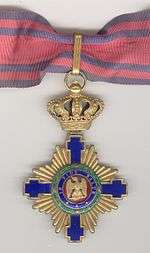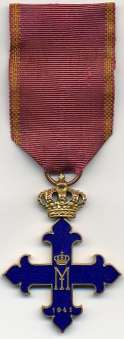Order of the Star of Romania
| Order of the Star of Romania Ordinul Steaua României | |
|---|---|
 | |
| Collar of the Order | |
| Awarded by The King of the Romanians (1877 - 1947) The President of Romania since 1998 | |
| Type | Order of Merit |
| Ribbon | Red with two thin Dark Blue stripes on either side. |
| Eligibility | (1) Civil, Military; (2) Military units; (3) Foreign citizens |
| Awarded for | (1) Exceptional civil and military services to the Romanian State and the Romanian people; (2) For special acts in time of peace or for heroic acts in time of war; (3) For contributing to the development of the friendship relations with Romania, or for other exceptional services to the Romanian State and the Romanian People. |
| Status | Currently awarded |
| Grand Master | President Klaus Iohannis |
| Grades (w/ post-nominals) | Grand Cross with Collar Grand Cross Grand Officer Commander Officer |
| Former grades | Knight/Dame |
| Statistics | |
| Established | 1877 - Romanian War of Independence |
| Precedence | |
| Next (higher) | Order of Michael the Brave |
| Next (lower) | Order of Faithful Service |
| | |
| The ribbon of the Order | |
The Order of the Star of Romania (Romanian: Ordinul Steaua României) is Romania's highest civil Order and second highest State decoration after the defunct Order of Michael the Brave. It is awarded by the President of Romania. It has five ranks, from lowest to the highest: Officer, Commander, Grand Officer, Grand Cross, and Grand Cross with Collar.
History
In 1863 Alexandru Ioan Cuza, the Domnitor of the United Principalities of Moldavia and Wallachia, asked the Romanian representative to Paris to contact the then well-known jewellery house Krétly, to manufacture a state decoration. Krétly presented a model, which was immediately accepted by the domnitor, and based on his agreement, 1,000 pieces of the order were made. It was decided that the order would have five ranks: Knight (Cavaler), Officer (Ofițer), Comandor (Comandor), Grand Officer (Mare Ofițer), and Grand Cross (Mare Cruce).
Unlike all other decorations in that time that were mostly inspired on the French Légion d'honneur, or which had their insignia like a Maltese cross, the model proposed by Krétly for this order was a blue cross crosslet (cruce repetată), a design that was then unique in decorational design.
The domnitor decided that the name of the honour would be "The Order of the Union" ("Ordinul Unirii"). It was planned to institute the order on 24 January 1864, the date when the 5th anniversary of his election would be celebrated and a moment that marked the unification of the principalities of Moldavia and Wallachia. Because of this, the motto of the new order would fit the event: "GENERE ET CORDES FRATRES" ("BROTHERS THROUGH ORIGINS AND FEELINGS"). The obverse of the insignia would bear the numbers "5" and "24", the days of January when he was elected in both Moldova and Wallachia.
However, due to the overthrow of Alexandru Ioan Cuza by a palace coup, he was unable to actually institute the order, and he awarded the insignia therefore only as a personal present, not as a state decoration. Most of the insignia produced for him remained stored in the Royal Palace's dungeons.

In April 1877, when Romania gained independence from the Ottoman Empire, the debate regarding the institution of Romanian decorations was revived. Mihail Kogălniceanu, Minister of Foreign Affairs in the Ion Brătianu cabinet, took part in the debates in the Assembly of Deputies regarding the institution of a state decoration. Because of the already earlier supplied "Order of The Union", it was decided that the shape of the decoration would be the same, modifying only the domnitor's seal. The motto was also changed, because the old one was not appropriate to the moment, to "IN FIDE SALUS" ("IN FAITH IS THE SALVATION"). Regarding the name, Kogălniceanu insisted on "Steaua Dunării" ("The Star of The Danube").

The name "Steaua României" ("The Star of Romania") appeared on May 10, 1887, when the law was voted in the Parliament, as the first law of the Sovereign Romania.
By Royal Decree (no. 1545/1932), King Carol II changed the order of precedence in the Romanian honours system. As a result, in 1932, The Star of Romania dropped in precedence from second place (where it had been since 1906) to fourth place (after the Order of Carol I and the Order of Ferdinand I). In 1937, it dropped to seventh place. The main shape of the order, the blue repeated cross (called also "Romanian cross") was kept, but the rays between the cross' arms were replaced by four heraldic eagles with wings spread, the insignia of King Carol I was placed on the obverse, and the reverse bore the year of its establishment, "1877". Also the number of persons that could be awarded The Star of Romania was increased:
- Knight (Cavaler): 1,000 civilians and 350 military;
- Officer (Ofițer): 500 civilians and 150 military;
- Commodore or Commander (Comandor): 200 civilians and 75 military;
- Grand Officer (Mare Ofițer): 75 civilians and 25 military;
- Grand Cross (Mare Cruce): 35 civilians and 10 military.
In 1938, the order was given a superior rank, called "Clasa I" (First Class in English), between the Grand Officer rank and the Grand Cross rank, with a maximum of 50 civilians and 15 military personnel.
The statutes established by King Carol II were changed by General Ion Antonescu (who became Conducător on 4 September 1940). Generally, the rules were the ones used during World War I. The order "The Star of Romania" became the second in the national hierarchy, after that of the Order of Michael the Brave.
Inspired by the German Iron Cross, Ion Antonescu decided that the first three grades of the orders the Star of Romania and the Crown of Romania, with spades (swords), and the ribbon of The Medal "The Military Virtue" would be awarded for exceptionally brave acts with an oak leaf, attached to the ribbon.
After 1948, all the existing decorations were outlawed, and their wearing was forbidden. Just by keeping the insignia, one was considered a delinquent in the first years of communism.
After many attempts, in 1998/1999 the National Order "The Star of Romania" was reinstituted, with a design similar to the one used in 1932, but without the insignia of King Carol I, and with the republican insignia.
Grades
As per Law 29/2000, regarding Romania's national system of decorations, there are currently six grades:[1]
- Collar (Colan)
- Grand Cross (Mare Cruce)
- Grand Officer (Mare Ofiţer)
- Commander (Comandor)
- Officer (Ofiţer)
- Knight (Cavaler)
Select recipients
First issue (1877-1948)
- Ernesto Burzagli, No. 67616.
- Archduke Eugen of Austria (1881)
- Jan Karcz
- Aristide Razu (1918)
- Hendrik Pieter Nicolaas Muller (1922)
- Artur Phleps (1920, 1933)
- Edward Rydz-Śmigły
- Jack Corbu (1930)
- Stanisław Maczek
- Amha Selassie of Ethiopia
- Rudolf Walden
- Fritz Witt (1942)
- Jagatjit Singh of Kapurthala (1935)
- Walter Staudinger (1942)
- Sultan Ismail of Johor (1942)
Second issue (since 1998)
Sash rank
Romanian: Colan
- Klaus Iohannis (2014)
Foreign citizens
- Jacques Chirac (1998)
- Alberto Fujimori (1998)
- Martti Ahtisaari (1998)
- Petăr Stoianov (1998)
- Aleksander Kwasniewski (1999)
- Thomas Klestil (1999)
- Constantinos Stephanopoulos (1999)
- Süleyman Demirel (1999)
- Harald V (1999)
- Hamad Bin Khalifa Al Thani (1999)
- Jaber Al-Ahmed Al-Jaber Al-Sabah (1999)
- Nursultan Nazarbaev (1999)
- Rexhep Meidani (1999)
- Ezer Weizman (1999)
- Petru Lucinschi (2000)
- Elizabeth II (2000)
- Jorge Fernando Branco de Sampaio (2000)
- Arpad Gontz (2000)
- Margareta II (2000)
- Rudolf Schuster (2000)
- Stjepan Mesić (2000)
- Ernesto Zedillo Ponce de Léon (2000)
- Fernando Henrique Cardoso (2000)
- Bhumibol Adulyadej (2000)
- Leonid Kucima (2000)
- Emile Lahoud (2001)
- Kofi Annan (2001)
- Beatrix (2001)
- Valdas Adamkus (2001)
- Vaira Vike-Freiberga (2001)
- Andrew Willoughby Ninian Bertie (2002)
- Zayed bin Sultan Al Nahyan (2002)
- Gloria Arroyo (2002)
- Milan Kucan (2002)
- Ferenc Madl (2002)
- George W. Bush (2002)
- Mario Chiaruzzi (2002)
- Giuseppe Maria Morganti (2002)
- Zine el Abidine ben Ali (2003)
- Carl XVI Gustaf (2003)
- Juan Carlos I (2003)
- Carlo Azeglio Ciampi (2003)
- Arnold Rüütel (2003)
- Fiorello Provera (2003)
- Henri of Luxembourg (2004)
- Angelo Sodano (2004)
- Edward Fenech-Adami (2004)
- Giuseppe Arzilli (2004)
- Ian CP Smith (2004)
- Roberto Raschi (2004)
- Ricardo Lagos (2004)
- Ilham Aliyev (2004)
- Abdullah II (2005)
- Tarja Halonen (2006)
- George Emil Palade (2007)
- Tarcisio Bertone (2008)
- Matthew Festing (2008)
- Lech Kaczyński (2009)
- Michel Sleiman (2009)
- Albert II of Monaco (2009)
- Albert II of Belgium (2009)
- Mihai Ghimpu (2010)
- George Abela (2010)
- Valdis Zatlers (2011)
- Toomas Hendrik Ilves (2011)
- Giorgio Napolitano (2011)
- Mark Gitenstein (2012)
- Mejdi Messaoudi (2014)
- Joachim Gauck (2016)[2]
Romanian citizens
Available seats: 9
- Teoctist (2007, Post-mortem)
- Mugur Isărescu (2010)
Grand Cross rank
- Queen Beatrix (2001)
- Yıldırım Akbulut (1999)
- Teoctist Arăpaşu (1999)
- Ehud Barak (1999)
- Bartholomew I of Constantinople (1999)
- Silvio Berlusconi (2002)
- Boutros Boutros-Ghali (2000)
- Diodoros of Jerusalem (1999)
- Doina Cornea (2000)
- Pat Cox (2002)
- Bülent Ecevit (1999)
- Laurent Fabius (1999)
- Rafik Hariri (2002)
- Henrik, Prince Consort of Denmark (2000)
- Jaap de Hoop Scheffer (2004)
- Mugur Isărescu (2000)
- Lionel Jospin (1999)
- Jean-Claude Juncker (2003)
- Karekin II (2000)
- Hüseyin Kıvrıkoğlu (1999)
- Liviu Librescu (2007, posthumous)
- Adrian Năstase (2002)
- George Palade (2000)
- Göran Persson (2004)
- Christian Poncelet (1999)
- Romano Prodi (2000)
- Jean-Pierre Raffarin (2004)
- George Robertson, Baron Robertson of Port Ellen (2000)
- Gil Carlos Rodriguez Iglesias (2002)
- Gerhard Schröder (2004)
- Queen Sofía of Spain (2003)
- Wolfgang Schüssel (2004)
- Walter Schwimmer (2001)
- Vassilios Skouris (2004)
- Edmund Stoiber (1999)
- Alexandru Todea (1999)
- Grigore Vieru (2009)
- Georg Wassilko von Serecki (1907)
- Radu Beligan (2008)
- Mariana Nicolesco (2008)
- Queen Paola of Belgium (2009)
- Moshe Kantor (2014)
- Count Hans H. Weiss (1926)
Grand Officer rank
- Nicolae Cajal (2000)
- Liviu Ciulei (2000)
- Ileana Cotrubaş (2000)
- Lucian Pintilie (2000)
- Dumitru Prunariu (2000)
- Elie Wiesel (2002)
Commodore rank
- Mircea Dinescu (2000)
- Alexandru Zub (2000)
- Lucian Croitoru (2000)
- Chris Lauzen (2006)
- Angela Gheorghiu (2010)
- Vasile Moldoveanu (2010)
- Ronald L. Burgess, Jr. (2012)
Officer rank
- Marian-Jean Marinescu (2000)
- Oleg Serebrian (2000)
- Randolph L. Braham (2004) (Returned 2005)
- Anton Crihan
Knight rank
- Tudor Gheorghe (2002)
- Gică Petrescu (2003)
- Corneliu Vadim Tudor (2004 till 2007, when it was withdrawn [3])
- Klaus Iohannis (2007)
- László Tőkés (2009 till 2016, when it was withdrawn)
- USMC MGen Samuel Calvin Cumming (WWI)
See also
References
- ↑ "LEGE nr. 29 din 31 martie 2000 privind sistemul national de decoratii al Romaniei". Monitorul Oficial al României. Retrieved 13 December 2015.
- ↑ "Iohannis i-a decorat pe preşedintele Germaniei şi pe partenera sa" (in Romanian). Mediafax. 22 June 2016. Retrieved 22 June 2016.
- ↑ http://www.9am.ro/stiri-revista-presei/2007-05-28/presedintele-basescu-i-a-retras-steaua-romaniei-lui-vadim-tudor.html
- (Romanian) Ordinul național "Steaua României", Presidency of Romania website
- (Romanian) Recipients of the order (Excel sheet), Presidency of Romania website
